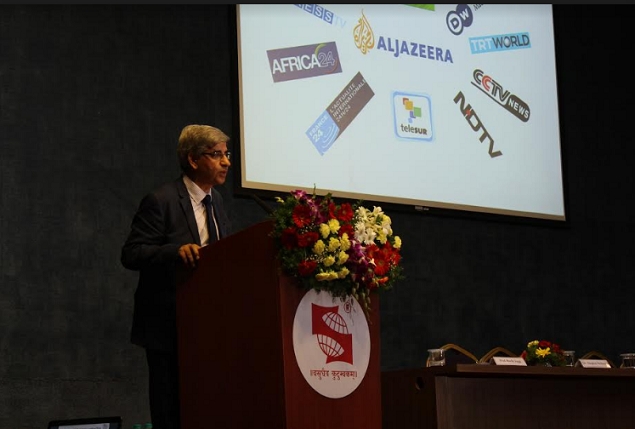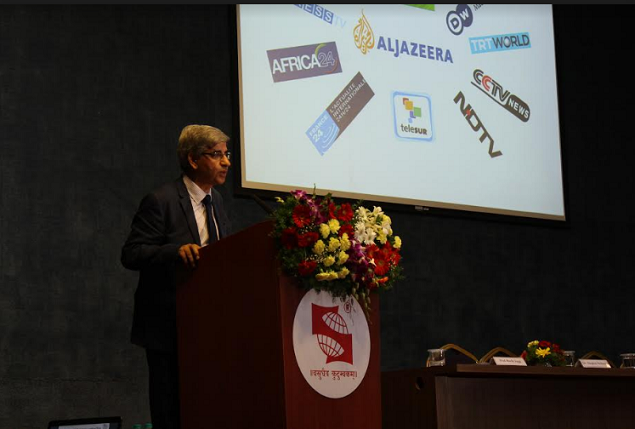
 Symbiosis Institute of Media & Communication (SIMC-PG) hosted the International Conference on Media and Communication: Prospects and Challenges on October 6 and 7. The event focused on the media industry and its future and what challenges and hurdles the media as a field will face. This was presented in the form of research papers by students of the institute.
Symbiosis Institute of Media & Communication (SIMC-PG) hosted the International Conference on Media and Communication: Prospects and Challenges on October 6 and 7. The event focused on the media industry and its future and what challenges and hurdles the media as a field will face. This was presented in the form of research papers by students of the institute.
The speakers consisted of an esteemed panel of academicians from international institutions including Daya Thussu, professor of International Communication and Co-Director of India Media Center, University of Westminster; Stephen McDowell, Director and Professor of Communication at CCI, Florida State University; Nishant Shah, professor in the Institute of Culture and Aesthetics of Digital Media, Leuphana University, Lueneburg and Suresh Ramanathan, professor of marketing at Texas A&M University. The two day conference also comprised of skype sessions with acclaimed professor Nick Couldry, a professor of Media, Communications and Social Theory at London School of Economics and Brian Patrick O’Donoghue, an esteemed journalist and recipient of 2016 First Amendment Award honoured by the Alaska Press Club. The international conference also aimed at broadening the discourse on niche areas of media and communication and its interdisciplinary nature, with organised track events that took place parallely all over the campus.
The conference commenced with a session by Daya Thussu which was titled ‘Past, Present and Future Trends in Communication Research’, where he discussed about China’s role and it gaining importance in the digital and global economic spheres. He also threw light on the democratisation of content on the internet and the world of international communication being challenging due to many players in the frame and no proper structure. While talking about India’s role in global news he said, “Indian voice in international news is absent and confined to diasporic areas where that no one can hear.”
Nishant Shah covering his topic ‘Of Heathens, Perverts and Dolphins’, expounded on the digital diversity and the natural need for connectivity in the present days along with an engaging discussion on a digital vs a non-digital user. Speaking about the imagination of a ‘user’ he said, “The digital does not allow you to customize. Within the digital, the role of reading has been designated to machine. Therefore, the unimagined user is sometimes going to take the form of the heathen, the pervert or the dolphin.”
Stephen McDowell addressed on the topic of ‘Challenges for Media & Communication Studies.’ He described how the focus shifts in the present scenario from the broader changes which take place in society to new media, since it is more exciting. He also explained the institutional approach to challenges which are the basic building blocks of media and communication. Speaking about the future of research in media and communication he said, “We have theories, methods and resources and there is a personal payoff in being in this field. External audiences will find our research significant.”
Suresh Ramanathan offered a fresh perspective while discussing his topic ‘Future of Consumer Behaviour Research’. He emphasised on innovation in research which is important since it helps in the research standing out and getting noticed. Addressing the students and delegates he spoke, “Being innovative is not easy, do not give up. You are the future. You have the opportunities to make a difference. There is a lot beyond the fire and wheel.” He also stressed on the importance to marry the power of observation offered by big data with the power of personal intuition.
The first day also had a video conference session with Nick Couldry, where he mentioned his new book ‘The Mediated Construction of Reality’ and explained about how corporates are trying to modify society. Further, he discussed about how social media cannot be seen as an alternative to mainstream media, but both work very closely. Concluding the session of the first day he spoke, “The issues of power and equality are becoming so large and so fundamental that they are of interest to all social sciences now and not just to media researchers.”
The second day of the conference commenced with a skype session with Professor Brian Patrick O’ Donoghue. He stressed on the fact that the way news is being consumed has changed. From just depending on one sole provider of news, people have multiple sources now. He asserted, “We (journalists) have lost our place as the sole provider of news. Even the consumers know that they can get the information on their own.”
The second day also witnessed parallel track events where delegates and students presented their research papers and were judged by esteemed academicians and experts from various other disciplines like law, management and health sciences etc and the conference came to an end with a valedictory session.
Amber Singh, a student of SIMC who attended the conference said, “The International Conference on Media and Communication 2016 was an enlightening experience. I never knew media and communication could have so many influences and so much potential for interdisciplinary collaboration. The future of research seems exciting to me and thanks to this conference I am now aware before I venture into the professional world.”
